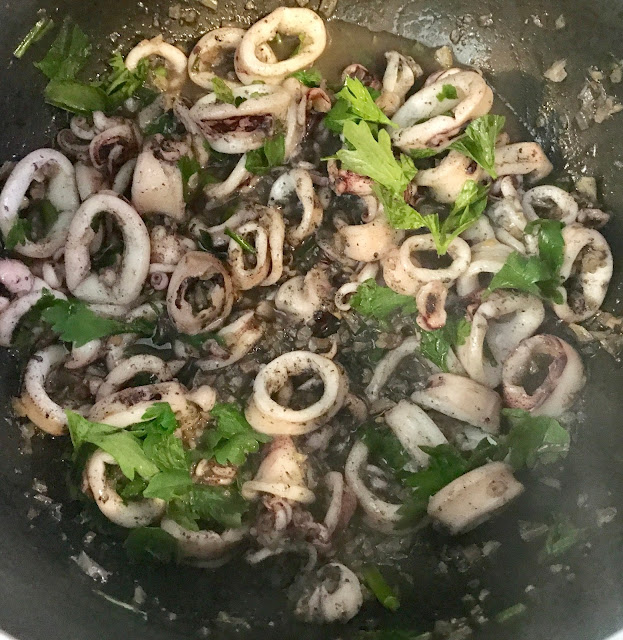Mugwort is an aromatic plant that grows widely across both cities and countryside. If you learn to recognize them, you will be surprised how many of them actually are available around you.
I love the subtle sage-like flavour of mugwort. Before I learnt foraging, I used to buy packs of dried mugwort leaves to make mochi (a type of Japanese glutenous sweet). I thought mugwort was some plant that you need to get deep in the wood and normal people would not have the novelty to forage it. So, after I learnt to recognize mugwort and started to spot them everywhere, I laughed at how silly I was spending money at the shop to buy mugwort.
Mugwort can grow more than six feet tall, and it has either pinkish flowers or light yellow flowers. However, young mugwort is easy to overlook among other green plants.
 |
Top on the left and underside on the right.
|
Mugwort’s leaves are greyish-green on the surface, and have sliver wooly hairs on the underside. Also, some parts of the stem is purple in colour (I didn’t capture that in my photo). When you rub it very close to the nose, you can smell a light sage-like scent.
Mugwort has an effect on stimulating blood flow around the uterus, and stimulate or ease menstruation.
SO PREGNANT WOMEN MUST NOT HAVE IT!
Many people said that mugwort can enhance vivid dreams. I’m not sure about that because I always remember my dreams in the morning. But putting a bunch of dried fragrant mugwort in the bedroom would be a nice idea.
For me, mugwort is a flavoring in dishes. I use it in soup, dessert, or tea.
Mugwort Salmon Soup
Ingredients:
1 pc Salmon, cut in bite size
1 handful Fresh Mugwort, leaf part only
4 cups Water
1/2 cup Milk
Salt to taste
How to make:
1. In a pot, combine the water and milk. Bring it to a boil.
2. Add salmon and mugwort. Continuously boil until the liquid comes back to a rolling boil again. Reduce the heat to medium.
3. Skim off the foam. Allow it to cook for another 5 minutes. Season it with salt.
Mugwort Panna Cotta
Ingredients:
1 cup Fresh Mugwort, leaf part only
3 cups Whole Milk
1/3 cup Sugar
8 gram Agar Agar
a small pinch of salt
How to make:
1. Combine all the ingredients in a pot. Bring it to a boil. Reduce the heat to a simmer and let it simmer until the agar agar is totally dissolved; about 20 minutes.
2. Drain and discard the mugwort. Divide the liquid evenly into the serving containers. Chill until it is set.
Mugwort Evening Tea
Ingredients:
A small handful of Fresh Mugwort Leaves
Hot Water
How to make:
1. Bring a cup of water to a rolling boil.
2. In a cup, add the washed mugwort. Pour in the hot water. Let it steep for about 8 minutes.
Mugwort Mochi (Glutinous Rice Ball
Ingredients: for 4 mochi
1 big handful of Fresh Mugwort, leaf part only
100 gram Glutinous Flour
150 ml Water
Corn Starch for coating
Red Bean Filling or any type of sweet filling
How to make:
1. To make the mugwort juice, combine the mugwort and water in a pot and bring it to a boil. Then, reduce the heat to medium-low and boil it for another 5 minutes. Turn off the heat and let it cool.
2. When the liquid is completely cool, blend it in a food processor.
Drain and discard the mugwort leaves. Measure the liquid; you will need about 150 ml for this recipe. Adjust the liquid with water if it’s needed.
 |
| From left to right. |
3. Add the glutinous flour into the liquid gradually and mix it with a spoon. Make sure the mixture has no lump.
4. Cover the bowl with a lid. Heat up the mixture in the microwave for 45 seconds. Take it out. Stir it vigorously with a spoon until it is sticky. (It should be done in 10 seconds). Cover the bowl again. Heat up the sticky mixture for another 40 seconds. Take it out and stir it again.
 |
From clockwise.
|
5. On a large plate, sprinkle a generous amount of corn starch. Pour the sticky dough on it. Coat both sides of the dough with cornstarch to prevent stickiness. Stretch the dough flat and divide it into 4 equal portions.
6. Press down a piece of dough, and then put a spoonful of filling in the middle. Wrap up four corners and place the mochi up-side-down.









































